0-概述
排序算法分类
常见的排序算法可以分为以下两大类:
- 比较类排序:通过比较来决定元素间的相对次序,由于其时间复杂度不能突破O(n*logn),因此也称为非线性时间比较类排序。
- 非比较类排序:不通过比较来决定元素间的相对次序,它可以突破基于比较排序的时间下界,以线性时间运行,因此也称为线性时间非比较类排序。
对于比较类排序,其时间复杂度不能突破O(n*logn),因为所有的比较动作可以构成一棵比较树(三叉树,每个分支对应<,=,>),N个元素的全排列数目为N!,即树中节点的个数为N!,则树高为log3(N!),而数学上可以证明:log3(N!)=Ω(n*logn),这就是基于比较的排序算法的时间复杂度下界。
对于非比较类排序,其可以达到线性时间复杂度,不过这一般是通过牺牲空间来换取的。
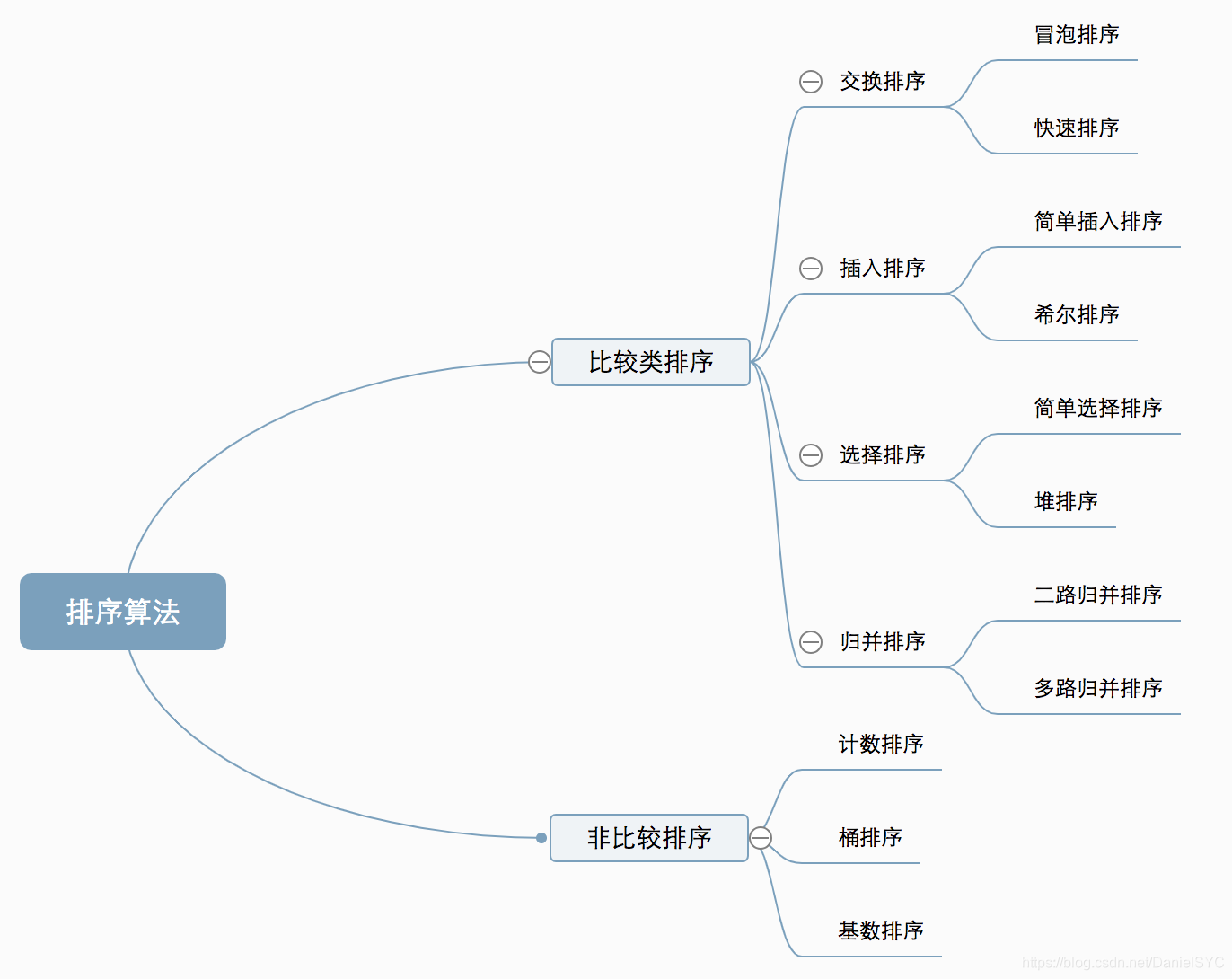
我们约定下面要讨论的排序算法的接口规范为:
void X_Sort(SortElemType A[],int N);,其中X是指排序算法的名称,并且约定:
- N是正整数,表示数组长度;
- 只讨论基于比较的排序(<,=,>有定义),而且为简单起见,只讨论从小到大的整数排序;
- 只讨论内部排序;
根据上述约定,我们的排序算法接口如下:
typedef int SortElemType;
//冒泡排序
void Bubble_Sort(SortElemType A[], int N);
//直接插入排序
void Insertion_Sort_directly(SortElemType A[], int N);
//折半插入排序
void Insertion_Sort_binary(SortElemType A[], int N);
//希尔排序
void Shell_Sort(SortElemType A[], int N);
//选择排序
void Selection_Sort(SortElemType A[], int N);
//堆排序
void Heap_Sort(SortElemType A[], int N);
//归并排序,递归版
void Merge_Sort_recursively(SortElemType A[], int N);
//归并排序,非递归版
void Merge_Sort_iteratively(SortElemType A[], int N);
//快速排序
void Quick_Sort(SortElemType A[], int N);
//计数排序
void Counting_Sort(SortElemType A[], int N);
//基数排序
void Radix_Sort(SortElemType A[], int N);
下面是一些不会提供给用户的辅助函数,只会被排序算法调用,其中有的很重要,是一些排序算法的core,而有的见名知意即可:
//交换两个数
static void swap(SortElemType* a, SortElemType* b);
//选择排序的核心:找到最小元
static int scanForMin(SortElemType* A, int begin, int end);
//堆排序的核心:向下过滤节点
static void percDown(SortElemType* A, int begin, int end);
//有序子列的归并
static void Merge(SortElemType A[], SortElemType TempA[], int L, int R, int RightEnd);
//归并排序的core
static void MSort(SortElemType A[], SortElemType TmpA[], int begin, int end);
//归并排序非递归算法核心
static void Merge_pass(SortElemType A[], SortElemType TempA[], int N, int length);
//为非递归归并排序服务的归并函数,与Merge相比,这个函数最后不会将元素倒回A中,只完成归并
static void Merge_simple(SortElemType A[], SortElemType TempA[], int L, int R, int RightEnd);
//选主元
static SortElemType Median3(SortElemType A[], int low, int high);
//划分
static int partition(SortElemType A[], int low, int high);
//快排核心
static void Quicksort(SortElemType A[], int low, int right);
//测试各种排序算法运行需要的ticks
static void testRunTime(void (*func)(SortElemType*, int), SortElemType* A, int N);
//检查数组是否已经排好序,这样就不用人工检查了
static void checkIsSorted(SortElemType A[], int N);
测试文件test.c
一个测试程序,可以通过测量排序函数运行所需的ticks(机器时钟打点数)来粗略比较各种排序算法性能的优劣。
首先从外部文件random_nums.c引入三个全局数组,里面存的是随机数,数组的size分别为200,2000,20000。
//从外部引入random_nums.c文件中的数组
extern int A_200[];
extern int A_2000[];
extern int A_20000[];
通过命令行参数指定要排序的数组(指针数组)和选用的排序算法(函数指针数组),格式如下:
$ ./x_sort 2 3
checkIsSorted:false
Selection_Sort:function ptr=0x55f266c14ccf,ticks=923723
checkIsSorted:true
$ ./x_sort 2 4
checkIsSorted:false
Heap_Sort:function ptr=0x55f17ec78d62,ticks=6165
checkIsSorted:true
./x_sort 2 5
checkIsSorted:false
Merge_Sort_recursively:function ptr=0x556822ea6e07,ticks=6550
checkIsSorted:true
第一个参数指定要排序的数组,0表示选用大小为200的随机数组A_200,1表示选用大小为2000的随机数组A_2000,2表示选用大小为20000的的随机数组A_20000。
第二个参数指定选用的排序算法,0表示冒泡排序,1表示插入排序……以此类推,具体的对应关系写在下面代码的注释中了。
主函数代码实现:
int main(int argc, char* argv[]) {
//从外部引入random_nums.c文件中的数组
extern int A_200[];
extern int A_2000[];
extern int A_20000[];
/*
在命令行参数中输入要选用的数组:
0-A_200
1-A_2000
2-A_20000
*/
int A_array_index = atoi(argv[1]);
/*
在命令行参数中输入要选用的排序算法:
0-冒泡排序
1-直接插入排序
2-折半插入排序
3-希尔排序
4-选择排序
5-堆排序
6-归并排序递归版
7-归并排序非递归版
8-快速排序
9-计数排序
10-基数排序
如果参数缺省会引发段错误,暂时就不必考虑健壮性了
*/
int sort_algorithm_array_index = atoi(argv[2]);
//指针数组,分别指向那三个A数组
int* A_array[3] = {A_200, A_2000, A_20000};
//函数指针数组,分别指向不同的排序算法函数
void (*sort_algorithm_array[11])(SortElemType*, int);
sort_algorithm_array[0] = Bubble_Sort;
sort_algorithm_array[1] = Insertion_Sort_directly;
sort_algorithm_array[2] = Insertion_Sort_binary;
sort_algorithm_array[3] = Shell_Sort;
sort_algorithm_array[4] = Selection_Sort;
sort_algorithm_array[5] = Heap_Sort;
sort_algorithm_array[6] = Merge_Sort_recursively;
sort_algorithm_array[7] = Merge_Sort_iteratively;
sort_algorithm_array[8] = Quick_Sort;
sort_algorithm_array[9] = Counting_Sort;
sort_algorithm_array[10] = Radix_Sort;
int* A = A_array[A_array_index];
int A_size = (int)200 * pow(10, A_array_index);
checkIsSorted(A, A_size);
//调用相应的函数并测量运行ticks
testRunTime(sort_algorithm_array[sort_algorithm_array_index], A, A_size);
checkIsSorted(A, A_size);
#ifdef PRINT_RESULT
for (int i = 0; i < A_size; ++i) {
printf("%d\t", A[i]);
}
#endif
return 0;
}
编译时需要将两个文件联编并且链接数学库,编译命令:
gcc test.c random_nums.c -o main -Wall -g -lm。如果调试时需要查看排序结果,可在编译时向程序中动态注入宏PRINT_RESULT,即添加编译选项-DPRINT_RESULT。
1-冒泡排序
算法思路

首先我们定义一个已排好序的标志int sorted=0,表示初始时未排好序;
只要!sorted,进入while循环:
- 首先假设已经排好序:
sorted=1; - 然后进入for循环从1开始向后扫描数组,一旦发现前面的比后面的大
A[i-1]>A[i],就交换两个数,同时sorted=0,这样,经过一轮循环,最大的元素就一定放在了最后面。 - 将待排数组规模减一
N--,进入下一次while循环。
若for循环扫描一遍后发现没有发生任何交换,说明数组已经有序sorted=1,!sorted不再满足,跳出while循环。
代码实现
void Bubble_Sort(SortElemType A[], int N) {
printf("%s:", __func__);
int sorted = 0;
while (!sorted) {
sorted = 1;
for (int i = 1; i < N; ++i) {
if (A[i - 1] > A[i]) {
swap(&A[i - 1], &A[i]);
sorted = 0;
}
}
N--;
}
return;
}
复杂度分析
- The best time complexity=O(n);
- The worst time complexity=O(n^2);
- Space complexity=O(1);
2-直接插入排序
算法思路

初始时将待排序列第一个元素看做一个有序序列,把第二个元素到最后一个元素当成是未排序序列。
然后从头到尾依次扫描未排序序列for (p = 1; p < N; ++p),取出未排序部分的第一个元素到tmp,并将tmp插入到前面有序序列的适当位置:i从p开始,只要i > 0 && tmp < A[i - 1],就不断地将A[i-1]向后移动 A[i] = A[i - 1];。
跳出内层for循环时,说明tmp已经找到了合适的位置,将其插入A[i] = tmp;。
可见插入排序对于链表是比较方便的,数组还要不断的挪动空间。
代码实现
void Insertion_Sort(SortElemType A[], int N) {
printf("%s:", __func__);
int tmp = 0;
int p, i;
for (p = 1; p < N; ++p) {
//外层循环每次取未排序部分的首个元素
tmp = A[p];
//从排好序的最后一个元素开始向前比较,只要tmp小,就将元素向后移
for (i = p; i > 0 && tmp < A[i - 1]; i--) {
A[i] = A[i - 1];
}
//就位
A[i] = tmp;
}
return;
}
复杂度分析
- The best time complexity=O(n);
- The worst time complexity=O(n^2);
- Space complexity=O(1);
3-折半插入排序
算法思路
整体思路与直接插入排序一样,但是由于前p个元素已经有序,在前向寻找插入位置时可以采用二分查找,这样就减少了关键字的比较次数。
代码实现
void Insertion_Sort_binary(SortElemType A[], int N) {
printf("%s:", __func__);
int low, mid, high;
int p;
for (p = 1; p < N; ++p) {
low = 0;
high = p - 1;
while (low <= high) {
mid = (low + high) / 2;
if (A[p] <= A[mid]) {
high = mid - 1;
} else {
low = mid + 1;
}
}
//跳出折半查找过程,low所指的位置就是待插入的位置
int tmp = A[p];
//将low..p的元素后移一位
for (int j = p; j > low; --j) {
A[j] = A[j - 1];
}
A[low] = tmp;
}
}
复杂度分析
- The best time complexity=O(n);
- The worst time complexity=O(n^2);
- Space complexity=O(1);
4-希尔排序
算法思路
希尔排序是对插入排序的一种改进,其时间复杂度有所优化,但希尔排序是不稳定的。
原理概述:将无序数组分割为若干个子序列,子序列不是逐段分割的,而是相隔特定的增量的子序列,对各个子序列进行插入排序;然后再选择一个更小的增量,再将数组分割为多个子序列进行排序。最后选择增量为1,即使用直接插入排序,使最终数组成为有序。
希尔排序的效果与选用的增量序列有关,效果比较好的是Sedgewick增量序列,这里为了简单起见这里我们用N/2,N/4……来充当增量序列。
举例来说,我们有下面10个待排数据,利用for循环for (D = N >> 1; D > 0; D >>= 1)产生增量序列。首先进行D=5间隔的插入排序:

p指向增量序列的下一个元素,取到tmp中,然后向前执行插入排序,只不过把原来插入排序-1的地方都换成了-D,表示D间隔的插入排序。
然后同理进行2间隔的插入排序,最后进行1间隔的插入排序,也就是传统的插入排序,但是由于序列此时已经基本有序,执行起来要快得多。

代码实现
void Shell_Sort(SortElemType A[], int N) {
printf("%s:", __func__);
int D = 0;
int tmp = 0;
int p, i;
// D为原始希尔序列
for (D = N >> 1; D > 0; D >>= 1) {
//执行D间隔的插入排序
for (p = D; p < N; p++) {
tmp = A[p];
for (i = p; i >= D && tmp < A[i - D]; i -= D) {
A[i] = A[i - D];
}
A[i] = tmp;
}
}
return;
}
复杂度分析
- The best time complexity≈O(n^1.3);
- The worst time complexity=O(n^2);
- Space complexity=O(1);
其最好时间复杂度和平均时间复杂度与选用的增量序列有关,精确的表达式在数学上尚未得到解决。
5-选择排序
算法思路

选择排序还是比较直观的:每次从未排序部分选出一个最小元,将其与未排序部分第一个元素交换即可。
代码实现
void Selection_Sort(SortElemType A[], int N) {
printf("%s:", __func__);
int minPositon = 0;
for (int i = 0; i < N; ++i) {
minPositon = scanForMin(A, i, N - 1);
swap(&A[i], &A[minPositon]);
}
return;
}
其中scanForMin是寻找子列中最小元位置的函数,实现如下:
static int scanForMin(SortElemType* A, int begin, int end) {
int minPosition = begin;
int minElem = A[begin];
for (int i = begin; i <= end; ++i) {
if (A[i] < minElem) {
minElem = A[i];
minPosition = i;
}
}
return minPosition;
}
复杂度分析
- Time complexity=O(n^2);
- Space complexity=O(1);
6-堆排序
算法思路
堆排序是对选择排序的改进。由上面选择排序的分析可知,其时间复杂度无论如何都是稳定的O(n^2),关键在于scanForMin的时间复杂度太高,达到了O(n),而堆排序就是利用堆的特性将scanForMin的过程优化为了O(logn)。
堆排序原理:
对于原始待排字母序列:
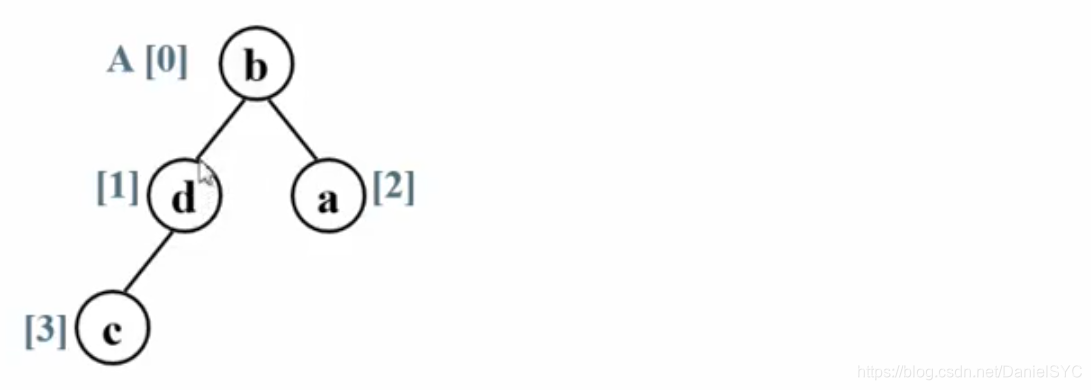
首先将其调整为一个大顶堆:

根据从小到大的排序规则,将堆顶元素(最大元素)与最后一个元素互换,这样就完成了最后一个数据的就位:

将待排数据的规模减一(红色虚线分割线),再将剩下的前三个元素调整为大顶堆:

再将堆顶与最后一个元素交换位置,待排数据规模减一,这样不断进行下去,最终序列有序。

下面的动画很好地演示的堆排序的过程:
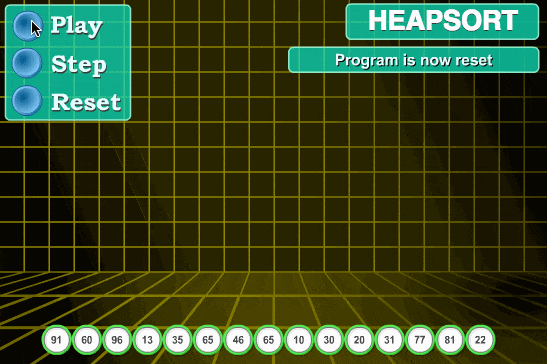
代码实现
void Heap_Sort(SortElemType A[], int N) {
printf("%s:", __func__);
for (int i = N / 2; i >= 0; --i) {
percDown(A, i, N);
}
for (int i = N - 1; i > 0; --i) {
swap(&A[0], &A[i]);
percDown(A, 0, i);
}
return;
}
其中percDown是向下过滤节点的函数。
代码实现如下:
static void percDown(SortElemType* A, int begin, int end) {
SortElemType top;
int Child;
top = A[begin];
while (2 * begin + 1 < end) {
Child = 2 * begin + 1;
if ((Child != end - 1) && A[Child + 1] > A[Child]) {
Child++;
}
if (top > A[Child]) {
break;
} else {
A[begin] = A[Child];
begin = Child;
}
}
A[begin] = top;
}
复杂度分析
- The best time complexity=O(n*logn);
- The worst time complexity=O(n*logn);
- Space complexity=O(1);
7-归并排序-递归版
算法思路

递归版本的归并排序采用分而治之的策略,每次求出待排序列的中点center = (begin + end) / 2;,然后递归地解决左半边,再递归地解决右半边,最后将从begin到center和从center+1到end的两个子列进行归并,递归终点是if (begin < end)。
下面的动画很好地演示了归并排序递归返回的过程:
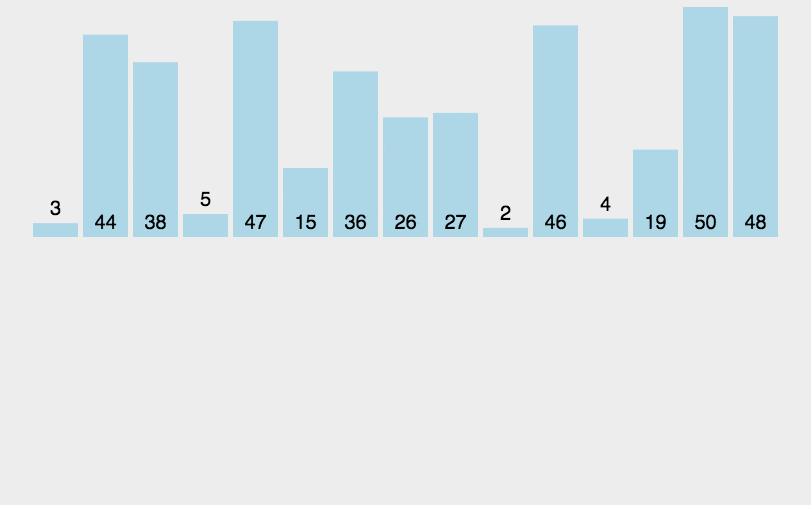
代码实现
void Merge_Sort_recursively(SortElemType A[], int N) {
printf("%s:", __func__);
SortElemType* TmpA = malloc(N * sizeof(SortElemType));
if (TmpA) {
MSort(A, TmpA, 0, N - 1);
free(TmpA);
}
return;
}
函数接口Merge_Sort_recursively只是申请了一个与A[]等长的辅助空间TmpA[],然后将其传递给MSort函数进行递归排序。MSort函数实现如下,其中参数TmpA的作用就是为了最后能传递给Merge函数,在MSort函数中没有实质性用处:
static void MSort(SortElemType A[], SortElemType TmpA[], int begin, int end) {
int center = 0;
if (begin < end) {
//求中点
center = (begin + end) / 2;
//递归的解决左半边
MSort(A, TmpA, begin, center);
//递归的解决右半边
MSort(A, TmpA, center + 1, end);
//将结果归并
Merge(A, TmpA, begin, center + 1, end);
}
}
Merge函数用于对两个子列进行归并,实现如下:
static void Merge(SortElemType A[], SortElemType TmpA[], int L, int R, int RightEnd) {
//左半部分终点
int LeftEnd = R - 1;
//存放结果数组TmpA的起始位置
int Tmp = L;
//元素数目
int NumElements = RightEnd - L + 1;
//当左右子序列都不为空
while (L <= LeftEnd && R <= RightEnd) {
//将小者放入A
if (A[L] <= A[R]) {
TmpA[Tmp++] = A[L++];
} else {
TmpA[Tmp++] = A[R++];
}
}
//左子序列有剩余
while (L <= LeftEnd) {
TmpA[Tmp++] = A[L++];
}
//右子序列有剩余
while (R <= RightEnd) {
TmpA[Tmp++] = A[R++];
}
//从后往前,将TmpA中的元素拷贝回A
for (int i = 0; i < NumElements; ++i) {
A[RightEnd] = TmpA[RightEnd];
RightEnd--;
}
}
复杂度分析
- Time complexity=O(n*logn);
- Space complexity=O(n);
8-归并排序-迭代版
算法思路
递归看上去比较直观,但是函数调用栈空间开销太大,优化为迭代能更好的提高效率,但是迭代版本的程序可能不好写一些(虽然说递归的程序也不好写)。

首先定义一个控制归并长度的length变量并申请与原数组等长的辅助空间TempA。
接下来进入while(length<N)循环:
-
首先进行
lenght=2的归并,相当于把整个序列分割为n/2组,各组内被归并有序。 -
接着进行
length=4的归并,相当于把整个序列分割为n/4组,各组内被归并有序。 -
……
-
不断的将
length乘以2,直到达到N/2,将整个序列归并有序。
代码实现
void Merge_Sort_iteratively(SortElemType A[], int N) {
printf("%s:", __func__);
int length = 1;
SortElemType* TempA = (SortElemType*)malloc(N * sizeof(SortElemType));
if (TempA != NULL) {
while (length < N) {
Merge_pass(A, TempA, N, length);
length *= 2;
Merge_pass(TempA, A, N, length);
length *= 2;
}
free(TempA);
}
return;
}
Merge_pass是用于实现一趟长度为lenght的归并的函数,在for循环中不断的调用归并函数Merge_simple(A, TempA, i, i + length, i + 2 * length - 1);,将左右两个子列进行归并,其中左起点为i,左终点为i+length-1,右起点为i+length,右终点为i+2*length-1。
注意for循环的终点是i < N - 2 * length,也就是最后会剩下一组或两组的尾巴,留作后续处理:
如果右起点i+length<N,则说明还够一趟归并的,再跑一次Merge_simple(A, TempA, i, i + length, N - 1);;
否则尾巴只剩一个左半部分了,直接追加到TempA中即可;
static void Merge_pass(SortElemType A[], SortElemType TempA[], int N, int length) {
int i, j;
for (i = 0; i < N - 2 * length; i += 2 * length) {
Merge_simple(A, TempA, i, i + length, i + 2 * length - 1);
}
if (i + length < N) {
Merge_simple(A, TempA, i, i + length, N - 1);
} else {
for (j = i; j < N; ++j)
TempA[j] = A[j];
}
return;
}
见名知意,Merge_simple就是上面的Merge函数的稍微简化版,改动之处在于最后归并的结果不再倒回A中,而是直接存放在TmpA中,代码实现如下:
static void Merge_simple(SortElemType A[], SortElemType TempA[], int L, int R, int RightEnd) {
int LeftEnd = R - 1;
int Tmp = L;
while (L <= LeftEnd && R <= RightEnd) {
if (A[L] <= A[R]) {
TempA[Tmp++] = A[L++];
} else {
TempA[Tmp++] = A[R++];
}
}
while (L <= LeftEnd)
TempA[Tmp++] = A[L++];
while (R <= RightEnd)
TempA[Tmp++] = A[R++];
return;
}
复杂度分析
- Time complexity=O(n*logn);
- Space complexity=O(n);
9-快速排序
算法思路

快速排序的最坏运行情况是 O(n2),比如说顺序数列的快排。但它的平摊期望时间是 O(nlogn),且 O(nlogn) 记号中隐含的常数因子很小,比复杂度稳定等于 O(nlogn) 的归并排序要小很多。所以,对绝大多数顺序性较弱的随机数列而言,快速排序总是优于归并排序。
算法概述:
-
从数列中挑出一个元素,称为 “基准”(pivot);
-
重新排序数列,所有元素比基准值小的摆放在基准前面,所有元素比基准值大的摆在基准的后面(相同的数可以到任一边)。在这个分区退出之后,该基准就处于数列的中间位置。这个称为分区(partition)操作;
-
递归地(recursive)把小于基准值元素的子数列和大于基准值元素的子数列排序;
伪码描述如下:

值得改进的地方:
- 对于快排函数
static void Quicksort(SortElemType A[], int Left, int Right),当数组规模较小时,为了减小递归深度,我们可以改用简单排序(如冒泡排序或插入排序等)来进行小规模数据的排序。例如我们可以设定一个阈值cutOff=100,当待排数组长度high - low小于阈值cutOff时,就使用简单排序。 - 主元的选定matters,如果我们每次都能选定序列的中位数作为pivot,就能达到最好的时间复杂度。这里我们选择了待排数组的头、中、尾这三个数的中位数进行近似。
代码实现
因为Quicksort函数是递归调用的,所以这里的Quick_Sort只是为了提供给用户统一的接口而对核心Quicksort函数进行了封装。
void Quick_Sort(SortElemType A[], int N) {
printf("%s:", __func__);
Quicksort(A, 0, N - 1);
return;
}
快排的核心:
static void Quicksort(SortElemType A[], int low, int high) {
static const int cutOff = 100;
if (high - low > cutOff) {
int pivotPosition = partition(A, low, high);
Quicksort(A, low, pivotPosition - 1);
Quicksort(A, pivotPosition + 1, high);
} else {
SortElemType* smallArray = A + low;
int N = high - low + 1;
int sorted = 0;
while (!sorted) {
sorted = 1;
for (int i = 1; i < N; ++i) {
if (smallArray[i - 1] > smallArray[i]) {
swap(&smallArray[i - 1], &smallArray[i]);
sorted = 0;
}
}
N--;
}
}
return;
}
划分:
static int partition(SortElemType A[], int low, int high) {
int pivot = Median3(A, low, high);
while (low < high) {
while (low < high && A[high] >= pivot) {
high--;
}
A[low] = A[high];
while (low < high && A[low] <= pivot) {
low++;
}
A[high] = A[low];
}
A[low] = pivot;
return low;
}
选主元:
经过三个if判断后,Left,Center,Right就从小到大有序了,最后将主元返回。
static SortElemType Median3(SortElemType A[], int low, int high) {
int center = (low + high) / 2;
if (A[low] > A[center]) {
swap(A + low, A + center);
}
if (A[low] > A[high]) {
swap(A + low, A + high);
}
if (A[center] > A[high]) {
swap(A + center, A + high);
}
return A[center];
}
复杂度分析
- The best time complexity=O(n*logn);
- The worst time complexity=O(n^2);
- Space complexity=O(logn);
10-计数排序
算法思路
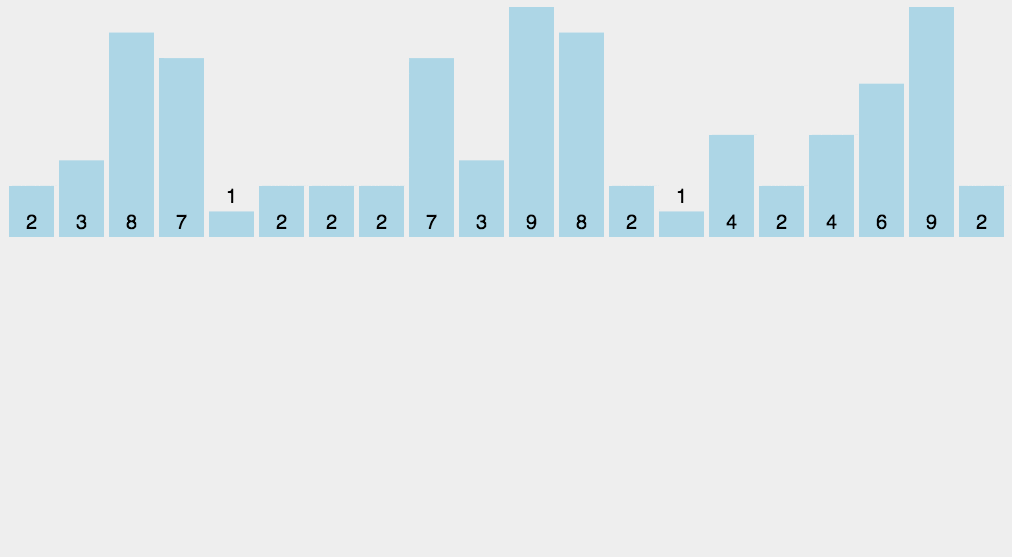
作为一种基于非比较类的排序,计数排序的的时间复杂度为O(n),但这是以牺牲空间为代价的,其空间复杂度为O(n+max),与数组中最大元素的值有关。
- 首先遍历一遍数组找到其最大值存入
max中。 - 接着开辟一个
max大小的辅助空间,也就是桶bucket。 - 接着遍历待排数组,将其每个元素
A[i]看做bucket的下标,执行bucket[A[i]]++。如果将数组看成一种map映射的话,其下标相当于key,数组元素值相当于value,遍历完成后,bucket中就存储了A中每个元素出现的次数。 - 最后从
0到max遍历bucket,利用bucket中保存的数组元素的出现次数的信息形成已排序数组。
代码实现
void Counting_Sort(SortElemType A[], int N) {
printf("%s:", __func__);
SortElemType max = A[0];
for (int i = 1; i < N; ++i) {
if (A[i] > max)
max = A[i];
}
SortElemType* bucket = (SortElemType*)malloc(sizeof(SortElemType) * max);
memset(bucket, 0, max);
if (bucket != NULL) {
for (int i = 0; i < N; ++i) {
bucket[A[i]]++;
}
for (int i = 0, j = 0; i <= max; ++i) {
while ((bucket[i]--) > 0)
A[j++] = i;
}
free(bucket);
return;
} else {
printf("空间不足\n");
return;
}
}
复杂度分析
- Time complexity=O(n);
- Space complexity=O(n+max);
11-基数排序
算法思路
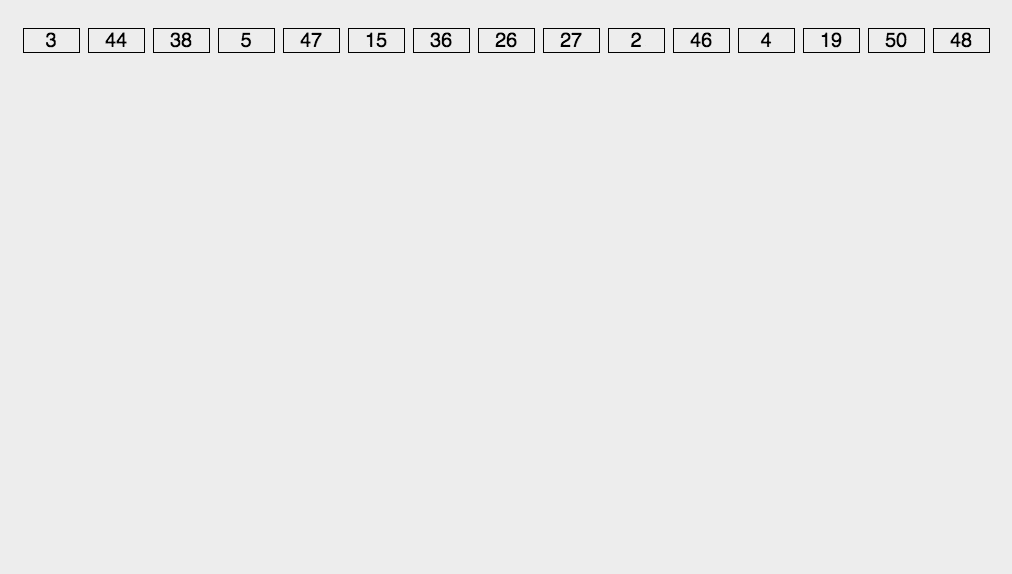
-
遍历序列找出最大的数
max,并确定其位数digit_num; -
开辟一个与数组
A大小相同的临时数组temp; -
进入外层对每一数位进行处理的循环
for (i = 1; i <= digit_num; ++i, radix *= 10;); -
用一个
count数组统计原数组中某一位(从低位向高位统计)相同的数据出现的次数; -
对
count数组进行递推累加,这样,count中的每个count[i]都保存了从count[0]到count[i]的和; -
最后和计数排序一样,利用
count中保存的数组元素的出现次数的信息形成已排序数组temp。 -
将
tmep数组拷回到原数组中,进入下一轮每一数位进行处理的循环;
代码实现
void Radix_Sort(SortElemType A[], int N) {
printf("%s:", __func__);
SortElemType max = A[0];
for (int i = 1; i < N; ++i) {
if (A[i] > max)
max = A[i];
}
int digit_num = 0;
while (max) {
max /= 10;
digit_num++;
}
SortElemType count[10];
SortElemType* temp = (SortElemType*)malloc(sizeof(SortElemType) * N);
int i, j, k;
int radix = 1;
for (i = 1; i <= digit_num; ++i, radix *= 10) {
memset(count, 0, 10 * sizeof(SortElemType));
for (j = 0; j < N; ++j) {
k = (A[j] / radix) % 10;
count[k]++;
}
for (j = 1; j < 10; ++j) {
count[j] = count[j - 1] + count[j];
}
for (j = N - 1; j >= 0; j--) {
k = (A[j] / radix) % 10;
temp[count[k] - 1] = A[j];
count[k]--;
}
//将temp中的元素倒回A
for (j = 0; j < N; ++j) {
A[j] = temp[j];
}
}
free(temp);
}
复杂度分析
- Time complexity=O(n);
- Space complexity=O(n);
11-测试函数运行时间
第一个参数为指向不同排序算法的函数指针*func,后两个参数为待排数组A和数组长度N,也就是*func的参数。
static void testRunTime(void (*func)(SortElemType*, int), SortElemType* A, int N) {
clock_t start, stop;
start = clock();
(*func)(A, N);
stop = clock();
printf("function ptr=%p,ticks=%ld\n", func, stop - start);
}
12-检查数组是否已经排好序
static void checkIsSorted(SortElemType A[], int N) {
for (int i = 1; i < N; ++i) {
if (A[i - 1] > A[i]) {
printf("%s:false\n", __func__);
return;
}
}
printf("%s:true\n", __func__);
return;
}
13-各种排序算法的比较
